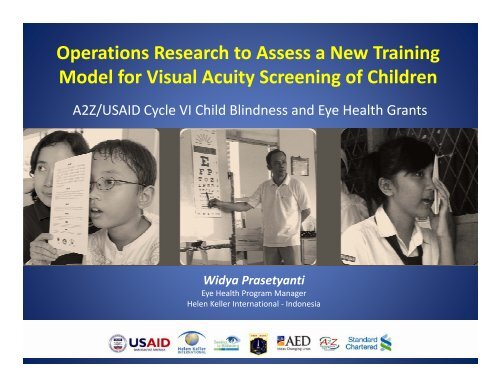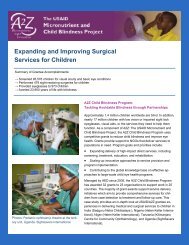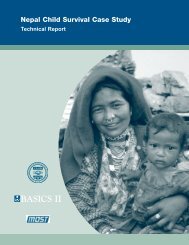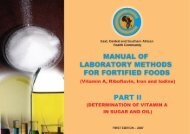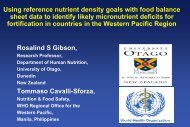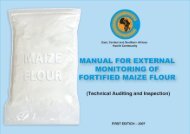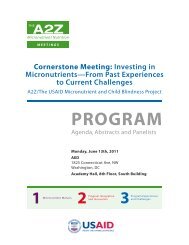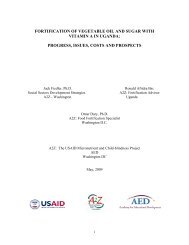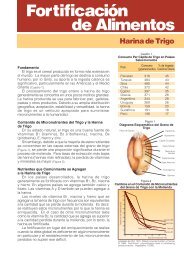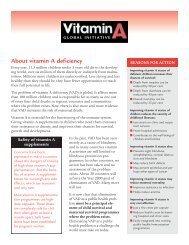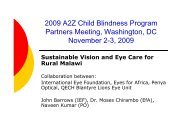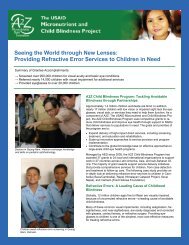Operations research to assess a new training model for visual acuity ...
Operations research to assess a new training model for visual acuity ...
Operations research to assess a new training model for visual acuity ...
Create successful ePaper yourself
Turn your PDF publications into a flip-book with our unique Google optimized e-Paper software.
<strong>Operations</strong> Research <strong>to</strong> Assess a New Training<br />
Model l<strong>for</strong> Visual Acuity Screening of Children<br />
A2Z/USAID Cycle VI Child Blindness and Eye Health Grants<br />
Widya Prasetyanti<br />
Eye Health Program Manager<br />
Helen Keller International ‐ Indonesia
About Helen Keller<br />
International<br />
Founded in 1915<br />
Headquarters in New York and offices in 22 countries<br />
Our mission is <strong>to</strong> prevent blindness and reduce<br />
malnutrition by bringing simple, proven and cost‐effective<br />
solutions <strong>to</strong> the people who need them most.
About Helen Keller<br />
International<br />
Reduce malnutrition<br />
Improve the lives of children with ihdisabilities<br />
i<br />
by increasing the capacity of governments <strong>to</strong> serve children with <strong>visual</strong><br />
impairments and other special needs<br />
Blindness prevention programs include:<br />
• Cataract Treatment<br />
• Onchocerciasis Control<br />
• Trachoma Control<br />
• Vision Correction/ChildSight®<br />
• Vitamin A Supplementation<br />
• Diabetic Retinopathy Treatment (<strong>new</strong>)<br />
• Neglected Tropical Diseases (<strong>new</strong>)
Program Objectives<br />
To improve the vision of junior high school students in<br />
poor areas of Jakarta and Surabaya, their teachers and<br />
their families<br />
To increase capacity <strong>for</strong> vision screening among<br />
teachers and health care workers<br />
To increase awareness of the importance of correcting<br />
refractive error and regular glasses wear in achieving<br />
good vision
Program Objectives<br />
To advocate <strong>for</strong> policy, systems and budgetary<br />
commitments on the part of key government<br />
stakeholders <strong>to</strong> support the program in a sustained<br />
fashion<br />
To create a program <strong>to</strong> provide vision services <strong>to</strong> the<br />
community in a sustainable manner.
Program Activities<br />
Screen ≈ 200,000 adolescent children, 5,000 school<br />
teachers in 200 schools or more in Jakarta and Surabaya<br />
Provide free eyeglasses yg <strong>to</strong> 40,000 students + 2,500<br />
teachers<br />
Train 900 teachers in RE screening<br />
T t 1 illi i di tb fi i i th h<br />
Target over 1 million indirect beneficiaries through<br />
media campaign
Using Teachers <strong>to</strong><br />
Screen<br />
Screening usually done at health centers (hospitals or<br />
community‐based) by medical staff (nurse,<br />
ophthalmologist)<br />
Training teachers as screeners is a <strong>new</strong> approach in<br />
Indonesia<br />
Quality of screening per<strong>for</strong>med by different screeners<br />
(including teachers, health workers, etc.) not known<br />
No standard curriculum <strong>for</strong> <strong>training</strong> teachers <strong>to</strong> do VA<br />
tests
Research Program<br />
Objective<br />
To compare screener <strong>training</strong> <strong>model</strong>s and identify the<br />
“preferred” approach <strong>for</strong> <strong>training</strong> teachers <strong>to</strong> screen <strong>for</strong><br />
<strong>visual</strong> <strong>acuity</strong> loss<br />
Location<br />
33 junior high schools<br />
in 5 cities in DKI Jakarta Province<br />
(North Jakarta, South Jakarta, West Jakarta, East Jakarta, Central Jakarta)<br />
Duration: 9 months (Oct 2010 – June 2011)
School Selection and<br />
Model Assignment<br />
g<br />
Randomly assign 33 schools <strong>to</strong> 2 <strong>training</strong> <strong>model</strong>s:<br />
Model A (N=17)<br />
A maximum of 5 teachers per school<br />
• 1‐2 from the School Health Unit (UKS)<br />
• 3‐4 selected dby the headmaster :<br />
• Currently assigned <strong>to</strong> the UKS<br />
• Classroom teachers or temporary<br />
teachers (non‐civil servants)<br />
Model B (N=16)<br />
15‐30 teachers per school—<br />
Prefer classroom and UKS teachers<br />
Additional criteria:<br />
Willing <strong>to</strong> spend 4 hours <strong>for</strong> participate <strong>to</strong> the <strong>training</strong><br />
Willing <strong>to</strong> spend 1‐2 hours per day <strong>to</strong> screen the students<br />
Willing <strong>to</strong> finish VA screening within 2 weeks.
Process<br />
Study Procedures‐<br />
Training<br />
1. Pre‐test<br />
2. Training<br />
3. Post‐test<br />
4. Training evaluation (by teachers)<br />
5. Training observation (by moni<strong>to</strong>ring<br />
team)<br />
Model A<br />
1 experienced trainer per <strong>training</strong> session<br />
Model B<br />
1 experienced trainer<br />
1 assistant per <strong>training</strong> session
Study Procedures‐<br />
Screening<br />
Student screening<br />
(by teachers)<br />
Screening observation<br />
(by moni<strong>to</strong>ring team)
Study Procedures‐<br />
Re‐screening<br />
Re‐screening<br />
(by Leprindo Academy Students)<br />
Re‐screening moni<strong>to</strong>ring<br />
(by moni<strong>to</strong>ring team)
Study Procedures‐<br />
Refraction<br />
Refraction (by HKI RE team)<br />
Glasses selection<br />
Lens preparation<br />
Fitting and distribution
Refractive Error<br />
Program Pro<strong>to</strong>col<br />
Teacher Training<br />
by the Refractionist<br />
Vision Screening of students<br />
by trained teacher<br />
Fail (VA = 6/18) Pass (VA = 6/12)<br />
Re‐screening by the<br />
Refraction Academy student ‐<br />
VA = 6/18<br />
Refraction examination by<br />
the Refractionist<br />
Re‐screening by the<br />
Refraction Academy student<br />
VA = 6/12<br />
No need further examination<br />
Need eyeglasses<br />
Eyeglasses distribution<br />
Need referral<br />
Referred <strong>to</strong> the<br />
ophthalmologist
Teacher<br />
Characteristics<br />
Model A (N=91) Model B (N=384)<br />
Female 67% 62%<br />
Mean age (years) 42 46<br />
Education<br />
High school 2% 6%<br />
Diploma<br />
Bachelor degree<br />
Master degree<br />
8%<br />
82%<br />
8%<br />
12%<br />
77%<br />
4%<br />
School health unit teachers 18% 6%<br />
Classroom teachers 56% 59%<br />
Subject teachers 91% 87%<br />
Non‐teaching staff 21% 17%<br />
Teaching experience (years) 16.5 20.8
Student<br />
Characteristics<br />
Model A<br />
(N=12318)<br />
Model B<br />
(N=11109)<br />
Female 53% 52%<br />
Mean age (years) 13.4 13.5<br />
Screening result<br />
Pass<br />
Fail<br />
9330 (77%)<br />
2799 (23%)<br />
8293 (76%)<br />
2670 (24%)<br />
Students refracted 2617 (21%) 2253 (20%)<br />
Recipient of glasses<br />
Glasses still in good condition<br />
Normal<br />
Refused<br />
Referred<br />
2094 (80%)<br />
199 (8%)<br />
309 (12%)<br />
8 (0.3%)<br />
7 (0.3%)<br />
1777 (79%)<br />
167 (7%)<br />
297 (13%)<br />
6 (0.3%)<br />
6 (0.3%)
Teacher Knowledge on<br />
Visual Acuity Screening<br />
Knowledge Area Tested Model 1 Model 2<br />
(% of correct answer) Pre Post Pre Post<br />
Definition of screening 64 99 44 97<br />
Definition of <strong>visual</strong> <strong>acuity</strong> 15 64 15 62<br />
Using SnellenChart 2 50 6 42<br />
Using near vision ii test 16 76 14 69<br />
Distance <strong>for</strong> <strong>visual</strong> <strong>acuity</strong> (6 meters) 39 99 29 97<br />
Screening procedures 26 78 16 80<br />
Other screening procedures 36 84 17 71
Training Successful<br />
Training <strong>to</strong>pics were delivered as per <strong>training</strong><br />
curriculum<br />
Topics were explained in a systematic way<br />
Ati Active discussion i between bt trainers and participants<br />
i t
Assessment of Training<br />
Technique<br />
Demonstrations with Snellen Chart were done<br />
Near distance test was correctly explained and<br />
practiced<br />
Participants received complete <strong>training</strong>/screening<br />
Participants received complete <strong>training</strong>/screening<br />
package (Snellen chart, screening <strong>for</strong>m, reading card,<br />
commitment letter, <strong>training</strong> module)
Areas <strong>for</strong> Improvement<br />
Provide additional demonstrations ti on how <strong>to</strong><br />
correctly fill screening <strong>for</strong>ms<br />
More coaching from the trainers on screening<br />
practice and recording
Screening Set Up<br />
Screening was conducted in‐doors 92%<br />
Adequate lighting 75%<br />
Crowded, noisy room 59%<br />
Screened in a group setting 56%<br />
Most teachers estimated distance based on tile size 70%
Screening Process<br />
Teachers use correct charts <strong>for</strong> near and distance vision >95%<br />
Majority of teachers received assistance 70%<br />
Record screening result 56%<br />
Guide reading of Snellen Chart 20%<br />
Do not record screening result directly in<strong>to</strong> <strong>for</strong>m 73%
Accuracy of Screening<br />
Screening<br />
Rescreening<br />
Screening result Pass Fail Pass Fail<br />
Full sample (N=23467) 76% 24%<br />
10% sample (N=2356) 75% 25% 78% 22%<br />
Sensitivity 79%<br />
Specificity 91%
Refraction outcomes<br />
Refraction result (N=4870) N %<br />
Eyeglasses<br />
Never wear glasses<br />
Wearing glasses<br />
Ever wearing glasses<br />
1927<br />
1642<br />
691<br />
45<br />
39<br />
16<br />
Spherical equivalent (Diopter) ‐2.00<br />
Student t status tt in refraction<br />
Recipient of glasses<br />
Normal<br />
Glasses still in good condition<br />
i<br />
Refused<br />
Referred<br />
3871<br />
606<br />
366<br />
14<br />
13<br />
80<br />
12<br />
8<br />
0.3<br />
0.3
Use of Research<br />
Results<br />
Development of <strong>training</strong> guidelines <strong>for</strong> other HKI<br />
Refractive Error and pediatric ophthalmology programs<br />
in Indonesia<br />
Revision of screening procedures <strong>for</strong> existing programs
Use of Results <strong>for</strong><br />
Policy Development<br />
Collaborate with local departments of health (provincial and<br />
district) <strong>to</strong> incorporate eye health and vision screening <strong>to</strong> the<br />
basic health curriculum <strong>for</strong> school health units.<br />
Involve refraction academy students in<strong>to</strong> school‐based and<br />
community‐based refraction activities <strong>to</strong> fill in gaps of<br />
inadequate human resources (within health system) on<br />
refraction<br />
Advocate <strong>for</strong> the standardization of VA screening modules and<br />
materials developed by government
Areas <strong>for</strong> Further<br />
Research<br />
Behaviors, barriers and facilitating fac<strong>to</strong>rs that affect<br />
eyeglass wear and compliance with referrals<br />
Effectiveness of using lay‐screeners <strong>for</strong> VA in<br />
adolescents
Acknowledgements<br />
USAID<br />
A2Z/AED<br />
Standard Chartered Bank<br />
Jakarta Provincial Department of Education<br />
Jakarta Provincial Department of Health<br />
Schools<br />
Headmasters<br />
LEPRINDO Refraction Academy


